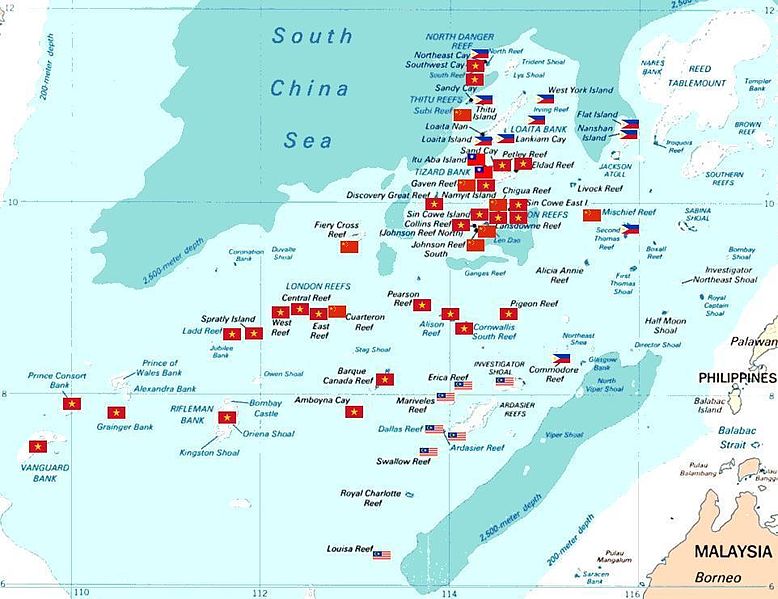Blackbeardsgoldfish
Committed member
A thread dedicated to Freedom of Navigation Operations conducted in the South China Sea and Taiwan Strait.
Some FONOPs that were conducted in 2022 so far:
On July 13/2022, USS Benfold conducted a transit through waters near the Paracel Islands, which are occupied by China but claimed by several nations. On July 16/2022, Benfold conducted a transit through areas claimed by China, Vietnam, and Taiwan in the Spratly Islands, demonstrating the freedom to navigate through "unlawful and sweeping maritime claims."
https://maritime-executive.com/arti...es-china-s-attention-with-back-to-back-fonops
May 10, 2022 11:52 AM • Updated: May 10, 2022 3:38 PM
Ticonderoga-class guided-missile cruiser USS Port Royal (CG-73) transitioned the Taiwan Strait Tuesday, the Navy announced in a release.
Port Royal, homeported in Hawaii, conducted a routine transit through the Taiwan Strait, according to a 7th Fleet release. The cruiser, one of the Ticonderoga-class slated to exit the fleet in five years, went through a corridor in the strait that is not part of territorial sea of a coastal state, according to the release.
The strait transit was done in accordance with international law.
https://news.usni.org/2022/05/10/u-...strait-days-after-chinese-naval-air-exercises
February 28, 2022 2:36 PM
A U.S. warship passed through the Taiwan Strait over the weekend, irking the Chinese government, which called the move “provocative.”
Arleigh Burke-class guided-missile destroyer USS Ralph Johnson (DDG-114) conducted a routine strait transit on Saturday, according to a press release from U.S. 7th Fleet. It operated in accordance with international law.
https://news.usni.org/2022/02/28/destroyer-uss-ralph-johnson-performs-taiwan-strait-transit
---------------------
The FONOPs Subsection of The Diplomat: https://thediplomat.com/tag/fonops/
The US Indo-Pacific Command Twitter: https://twitter.com/INDOPACOM
Some FONOPs that were conducted in 2022 so far:
USS Benfold Catches China's Attention With Back-to-Back FONOPs
The U.S. Navy conducts a slow but steady pace of FONOPs in the South China Sea, demonstrating U.S. presence and challenging China's sweeping maritime claims in the region. However, it is rare to see two of these transits in a week.On July 13/2022, USS Benfold conducted a transit through waters near the Paracel Islands, which are occupied by China but claimed by several nations. On July 16/2022, Benfold conducted a transit through areas claimed by China, Vietnam, and Taiwan in the Spratly Islands, demonstrating the freedom to navigate through "unlawful and sweeping maritime claims."
https://maritime-executive.com/arti...es-china-s-attention-with-back-to-back-fonops
U.S. Cruiser Transits Taiwan Strait Days After Chinese Naval, Air Exercises
By: Heather MongilioMay 10, 2022 11:52 AM • Updated: May 10, 2022 3:38 PM
Ticonderoga-class guided-missile cruiser USS Port Royal (CG-73) transitioned the Taiwan Strait Tuesday, the Navy announced in a release.
Port Royal, homeported in Hawaii, conducted a routine transit through the Taiwan Strait, according to a 7th Fleet release. The cruiser, one of the Ticonderoga-class slated to exit the fleet in five years, went through a corridor in the strait that is not part of territorial sea of a coastal state, according to the release.
The strait transit was done in accordance with international law.
https://news.usni.org/2022/05/10/u-...strait-days-after-chinese-naval-air-exercises
Destroyer USS Ralph Johnson Performs Taiwan Strait Transit
By: Heather MongilioFebruary 28, 2022 2:36 PM
A U.S. warship passed through the Taiwan Strait over the weekend, irking the Chinese government, which called the move “provocative.”
Arleigh Burke-class guided-missile destroyer USS Ralph Johnson (DDG-114) conducted a routine strait transit on Saturday, according to a press release from U.S. 7th Fleet. It operated in accordance with international law.
https://news.usni.org/2022/02/28/destroyer-uss-ralph-johnson-performs-taiwan-strait-transit
---------------------
The FONOPs Subsection of The Diplomat: https://thediplomat.com/tag/fonops/
The US Indo-Pacific Command Twitter: https://twitter.com/INDOPACOM




